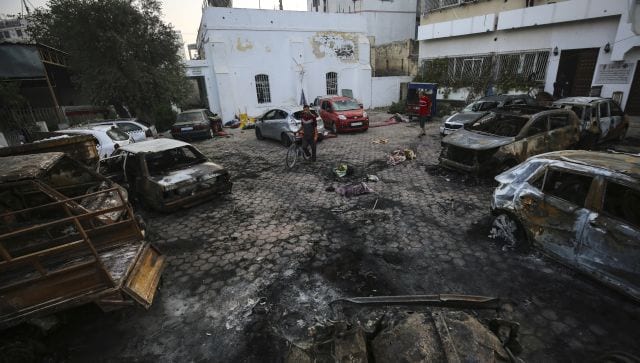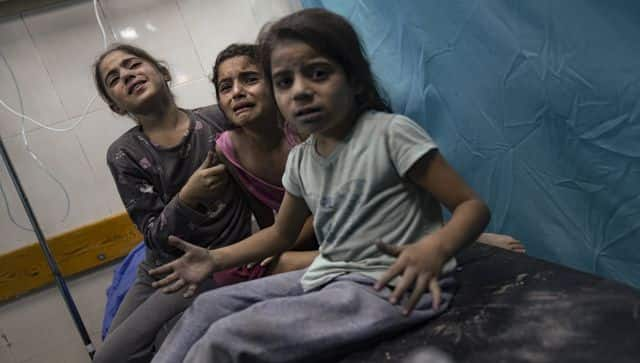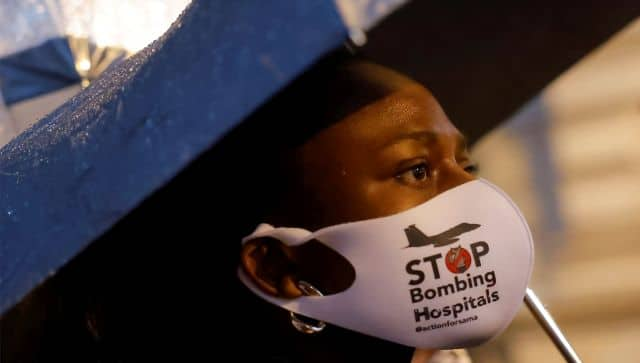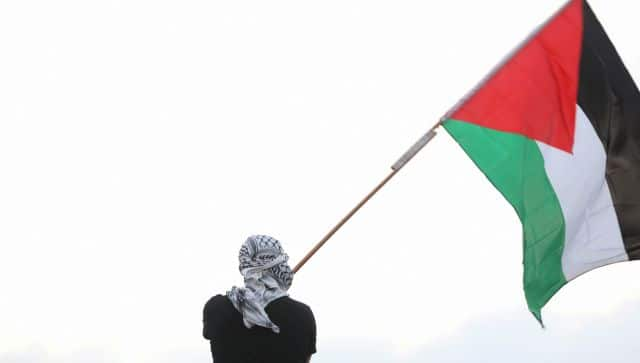The deadly explosion at the Al-Ahli hospital in Gaza City that left hundreds dead has caused widespread outrage. Protests erupted in West Asia and spread to other parts of the world even as the blame game over the attack continues. The Hamas-controlled authorities in
Gaza
have held Israel responsible, but Israel has denied it was involved. Jerusalem has said it has nothing to do with the explosion and has pointed fingers at the Palestinian Islamic Jihad. The militant group has refuted the allegations. The United States got involved. President
Joe Biden
, who was visiting Tel Aviv on Wednesday, backed Israel’s stance. In remarks to Prime Minister Benjamin Netanyahu, the US president said the evidence he had seen suggested it was “the other team” that was responsible for the explosion at the hospital in Gaza City on Tuesday night. According to the Gaza health ministry, 471 people were killed in the bombing. As
claims and counterclaims continue
, we take a look at what we know about the attack and questions that remain unanswered. [caption id=“attachment_13270232” align=“alignnone” width=“640”] Palestinians check the place of the explosion at al-Ahli hospital, in Gaza City, on 18 October. The Hamas-run Health Ministry says an Israeli airstrike caused the explosion that killed hundreds, but the Israeli military says it was a misfired Palestinian rocket. AP[/caption] What happened at the Al-Ahli hospital? The blast hit the
Gaza hospital
around 19.00 local time. A 20-second video circulation on social media purportedly of the blast was among the first evidence to emerge of the incident. You can hear the sound of an incoming projectile, which is followed by an explosion and fire, according to a BBC report. Live footage from the Al-Jazeera media network shows a bright light in the skies, which flashes twice before changing direction and then exploding, the report says. A video that The Associated Press (AP) confirmed as being from the hospital showed an orange ball of fire and flames engulfing the building and grounds. It showed the outside of the hospital, where countless Palestinian families had been camping out. Torn bodies covered the grass, with slain children lying among dead adults. According to the BBC, which studied visual evidence from the blast site, the explosion occurred in the courtyard, which is part of the hospital.
Palestinians check the place of the explosion at al-Ahli hospital, in Gaza City, on 18 October. The Hamas-run Health Ministry says an Israeli airstrike caused the explosion that killed hundreds, but the Israeli military says it was a misfired Palestinian rocket. AP[/caption] What happened at the Al-Ahli hospital? The blast hit the
Gaza hospital
around 19.00 local time. A 20-second video circulation on social media purportedly of the blast was among the first evidence to emerge of the incident. You can hear the sound of an incoming projectile, which is followed by an explosion and fire, according to a BBC report. Live footage from the Al-Jazeera media network shows a bright light in the skies, which flashes twice before changing direction and then exploding, the report says. A video that The Associated Press (AP) confirmed as being from the hospital showed an orange ball of fire and flames engulfing the building and grounds. It showed the outside of the hospital, where countless Palestinian families had been camping out. Torn bodies covered the grass, with slain children lying among dead adults. According to the BBC, which studied visual evidence from the blast site, the explosion occurred in the courtyard, which is part of the hospital.
The head of orthopaedic surgery at Al-Ahli hospital, Fadel Naim, had just finished a procedure when he heard a huge explosion and his department filled with people screaming for help. “People came running into the surgery department screaming help us, help us, there are people killed and wounded inside the hospital,” he is quoted as saying by Reuters. “The hospital was full of dead and wounded, dismembered bodies. We tried to save whoever could be saved but the number was too great for the hospital team,” he said. How many people were killed in the blast? According to Gaza’s health ministry, 471 people were killed. An AP report on Wednesday quoted the ministry as saying that at least 500 were dead in the attack. The Israeli Defence Forces (IDF) said that this number has been inflated on purpose. However, it did not release a toll. The exact number is not known and it is difficult to independently confirm the number of casualties. Photos from the blast site show bodies lying lifeless on the ground and injured women and children. Several children covered in dust are seen being treated for their wounds. [caption id=“attachment_13270252” align=“alignnone” width=“640”] Palestinian children wounded in the Israeli bombardment of the Gaza Strip for treatment in a hospital in Khan Younis. AP[/caption] What has Israel said? Israel has denied involvement and even provided evidence that supports that it wasn’t an Israeli bomb that exploded at the hospital. It blamed Palestinian militants, saying that an outgoing Islamic Jihad rocket misfired. To back their claims, Israel released a series of videos of the blast, one of which shows the hospital and surroundings after being hit by the rocket. “A failed rocket launch by the Islamic Jihad terrorist organisation hit the Al Ahli hospital in Gaza City. IAF footage from the area around the hospital before and after the failed rocket launch by the Islamic Jihad terrorist organization," IDF said and shared the video on X.
Palestinian children wounded in the Israeli bombardment of the Gaza Strip for treatment in a hospital in Khan Younis. AP[/caption] What has Israel said? Israel has denied involvement and even provided evidence that supports that it wasn’t an Israeli bomb that exploded at the hospital. It blamed Palestinian militants, saying that an outgoing Islamic Jihad rocket misfired. To back their claims, Israel released a series of videos of the blast, one of which shows the hospital and surroundings after being hit by the rocket. “A failed rocket launch by the Islamic Jihad terrorist organisation hit the Al Ahli hospital in Gaza City. IAF footage from the area around the hospital before and after the failed rocket launch by the Islamic Jihad terrorist organization," IDF said and shared the video on X.
According to the
Israeli military
, their rockets have a very high impact and create craters. It said that there were no visible craters near the hospital and the building did not encounter severe damage. When questioned about the size of the explosion, chief Israeli military spokesperson Rear Admiral Daniel Hagari said it was consistent with unspent rocket fuel catching fire. “Most of this damage would have been done due to the propellant, not just the warhead,” he said. The IDF also released an audio, which it claimed captured a conversation between two Hamas operatives. They spoke of a rocket launch from a cemetery near the hospital. According to an IDF, one of the alleged operatives says, “They are saying that the shrapnel of the missile is local shrapnel and not like the Israeli shrapnel.” However, publications like BBC and CNN have not been able to verify the authenticity of the recordings. [caption id=“attachment_13270262” align=“alignnone” width=“640”] Demonstrators hold a vigil outside Downing Street in solidarity with Palestinians after the hospital blast in Gaza, amid the ongoing conflict between Israel and Hamas, in London, on 18 October. Reuters[/caption] What has US intelligence revealed The
US government and security experts
have said that the early evidence shows that the explosion at the hospital was in all likelihood caused by a local militant group. US officials, who spoke on the condition of anonymity told The New York Times (NYT), said they were basing their early analysis on multiple strands of intelligence indicating that the blast at Gaza hospital was caused by
Palestinian Islamic Jihad
. The American intelligence, first mentioned by President Biden, includes satellite and other infrared data showing a launch of a rocket or missile from Palestinian fighter positions within Gaza. Video recordings by journalists and others show that the projectile did not come from the direction of Israeli military positions, officials told NYT. According to Adrienne Watson, a spokeswoman for the National Security Council, the US government assessment showed that Israel was not responsible for the explosion. “Our assessment is based on available reporting, including intelligence, missile activity and open-source video and images of the incident,” she said. Initial evidence gathered by the US intel community suggests that the hospital strike came from a rocket launched by the Palestinian Islamic Jihad. [caption id=“attachment_13270282” align=“alignnone” width=“640”]
Demonstrators hold a vigil outside Downing Street in solidarity with Palestinians after the hospital blast in Gaza, amid the ongoing conflict between Israel and Hamas, in London, on 18 October. Reuters[/caption] What has US intelligence revealed The
US government and security experts
have said that the early evidence shows that the explosion at the hospital was in all likelihood caused by a local militant group. US officials, who spoke on the condition of anonymity told The New York Times (NYT), said they were basing their early analysis on multiple strands of intelligence indicating that the blast at Gaza hospital was caused by
Palestinian Islamic Jihad
. The American intelligence, first mentioned by President Biden, includes satellite and other infrared data showing a launch of a rocket or missile from Palestinian fighter positions within Gaza. Video recordings by journalists and others show that the projectile did not come from the direction of Israeli military positions, officials told NYT. According to Adrienne Watson, a spokeswoman for the National Security Council, the US government assessment showed that Israel was not responsible for the explosion. “Our assessment is based on available reporting, including intelligence, missile activity and open-source video and images of the incident,” she said. Initial evidence gathered by the US intel community suggests that the hospital strike came from a rocket launched by the Palestinian Islamic Jihad. [caption id=“attachment_13270282” align=“alignnone” width=“640”] A man waves a Palestinian flag, as people take part in a pro-Palestinian protest in Amman, Jordan, after hundreds of Palestinians were killed in the blast in Gaza. Reuters[/caption] What are other experts saying? A crater outside the hospital has generated a lot of interest. The Guardian reports that the exact location of the impact on the ground where the blast occurred shows a crater in the compound of the hospital that experts describe as “fairly shallow”. “You don’t have a three-to-nine-meter — that’s about a 10-to-30-foot — crater that I would normally expect from an Israeli JDAM, which is a Joint Direct Attack Munition, a GPS-guided bomb, which is typical for what the Israelis would use here,” Marc Garlasco, a military adviser at PAX Protection of Civilians and a former US defence department analyst, told _PBS News Hou_r. Joint direct attack munition (JDAM) is a precision-guided air-to-surface weapon system that is part of the Israeli arsenal provided by the US. “You also see a lot of surface damage and fire damage and very little damage to any of the buildings. And these are some of the telltale signs that I would be looking for an airstrike, particularly from the types of weapons that Israel employs,” he said. Apart from this, no missile fragments have been found at the explosion site. “Projectiles are often identifiable by the wreckage of their shell, and they can be used to determine the projectile’s origin. But in this case, we have not seen that evidence,” says the BBC in its report. Justin Bronk, a senior research fellow for air power and military technology at RUSI in London, told The Guardian the extent of the damage revealed that “an airstrike looks less likely than a rocket failure causing an explosion and fuel fire.” With inputs from agencies
A man waves a Palestinian flag, as people take part in a pro-Palestinian protest in Amman, Jordan, after hundreds of Palestinians were killed in the blast in Gaza. Reuters[/caption] What are other experts saying? A crater outside the hospital has generated a lot of interest. The Guardian reports that the exact location of the impact on the ground where the blast occurred shows a crater in the compound of the hospital that experts describe as “fairly shallow”. “You don’t have a three-to-nine-meter — that’s about a 10-to-30-foot — crater that I would normally expect from an Israeli JDAM, which is a Joint Direct Attack Munition, a GPS-guided bomb, which is typical for what the Israelis would use here,” Marc Garlasco, a military adviser at PAX Protection of Civilians and a former US defence department analyst, told _PBS News Hou_r. Joint direct attack munition (JDAM) is a precision-guided air-to-surface weapon system that is part of the Israeli arsenal provided by the US. “You also see a lot of surface damage and fire damage and very little damage to any of the buildings. And these are some of the telltale signs that I would be looking for an airstrike, particularly from the types of weapons that Israel employs,” he said. Apart from this, no missile fragments have been found at the explosion site. “Projectiles are often identifiable by the wreckage of their shell, and they can be used to determine the projectile’s origin. But in this case, we have not seen that evidence,” says the BBC in its report. Justin Bronk, a senior research fellow for air power and military technology at RUSI in London, told The Guardian the extent of the damage revealed that “an airstrike looks less likely than a rocket failure causing an explosion and fuel fire.” With inputs from agencies
)